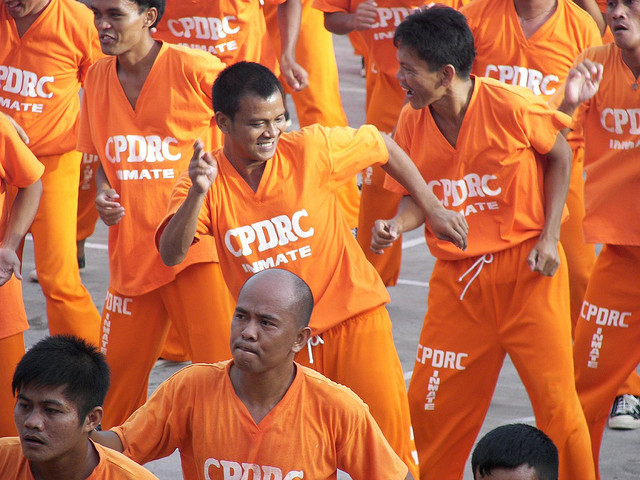The chief of the prison, Byron F Garcia, scion of one of the Philippines most powerful political families, originated the idea when looking for a way to keep his prisoners fit and active – both physically and mentally. Song and dance is an integral part of Philippine culture so when he conceived of something akin to Busby Berkeley numbers for the incarcerated - with all of their visual appeal of hundreds of people in choreographed unity - he was on to a winner.
Once the Thriller video had become an internet meme, he quickly followed it up with other songs which had previously been global hits in their own right, including In the Navy and YMCE by the Village People – ironically used, it seems, to persuade the more macho prisoners in the jail to join in the fun and the process of rehabilitation.
There is a smaller women’s section attached to the main prison and the female inmates are also allowed to take part in the dance routines. However, some of the female roles in the dance routines are taken by male prisoners who are disposed to a little cross dressing.
And there is the moot point really – almost immediately after the first video was posted online, many experts pointed out that the likelihood of dance routines being useful for rehabilitation – let alone enabling them to avoid recidivism – was, well, not that likely to be frank. Not only that but Garcia (pictured above) and his staff were also accused of using coercion and violence to encourage the prisoners to participate in the routines. When interviewed, both Garcia and the inmates have strenuously denied any abuse – but to paraphrase Mandy Rice-Davies, they would say that, wouldn’t they?
On the face of it, Garcia’s dance programme does have certain merits – the prison is overcrowded and cramped – and its prisoners not known, on the outside world at least, for their patience with others. In 2007 over three hundred of them were awaiting trial for murder. The gangs in which they operated on the outside world were thriving in the custodial atmosphere of the penitentiary.
Garcia needed to break down these factions on the inside in order to ensure that the prisoners could have a gang-free start on their eventual release. There is no death penalty in the Philippines at the moment so most of the prisoners in the pictures here will at some future point be released. Yet you can’t help but wonder what the reaction of death row prisoners in the USA might be, were they to be told that they were to participate in something similar.
The prison chief’s brainchild got off to a shaky start – many of the staff at the prison were wary about the sheer scale of the project in terms of prisoner participation. The prisoners, too, were not ecstatic at the prospect of putting on their dancing shoes for the world – one visiting choreographer was battered under a barrage of slippers upon his arrival at the penitentiary. However, eventually the idea took hold through the gentle persuasive techniques of the chief and his staff and although the first routine took a while to master, after six months the experiment was deemed a success.
On the subject of footwear, it is said that many of the prisoners – who must practice for many hours a day wearing only cheap prison provided sandals – have suffered from a variety of foot related complaints yet when the video was first released in 2007 it became an instant hit – with millions scratching their heads at the bizarre end result of Garcia’s rehabilitation through dance initiative.
Let’s face it – the sight of 1500 prisoners all dancing in unison is going to garner a few hits on the internet, as well as the associated advertising revenue that comes for the owner of the YouTube channel upon which it was posted. Row upon row of orange clad inmates, with the P for Prisoner writ large on their backs, dancing complex movements in apparent harmony, is something of a feast for the eyes.
It was of no surprise, then, that the prison soon began to charge the throng of tourists turning up to watch the prisoners dance in the flesh. Visitors can have their pictures taken with the prisoners and buy t-shirts as a memento of their visit. Rehabilitation can turn a profit, it seems, but of course the serious moral purpose underpinning the project was hardly likely to be forgotten.
In fact the contestants from the Philippine version of Celebrity Big Brother found themselves unwittingly parachuted (not literally) in to the prison to lend their D-list skills to this important social project. This is all part of what Garcia has referred to as ‘revolutionized penology’ yet it is hardly a new concept. Jeremy Bentham posited a panopticon prison in 1785 which allowed the public and jailers to watch prisoners without the prisoners being aware of being watched. YouTube adequately fulfils that function in the twenty first century.
You could say, too, that the reproduction of these pictures here has a relative moral ambiguity.
It is a good question – the one worth millions of dollars figuratively and literally – do the prisoners participate in a process of rehabilitation through these dance spectaculars? Some professors of criminal justice have denounced the activities as the CPDRC while their captors insist that it is a fundamentally unflawed way of encouraging prisoners to put themselves together physically and perhaps even spiritually. If only the persistent rumors of widespread abuse and coercion were not so, well, persistent, they might – just might - have a point.
On Youtube: http://www.youtube.com/watch?v=hMnk7lh9M3o

































No comments:
Post a Comment
Note: Only a member of this blog may post a comment.